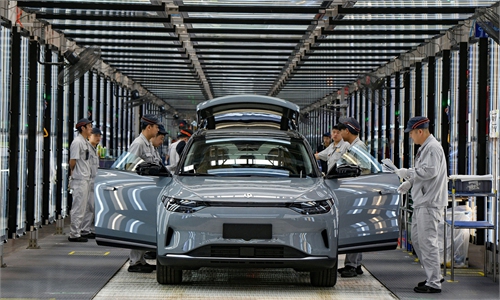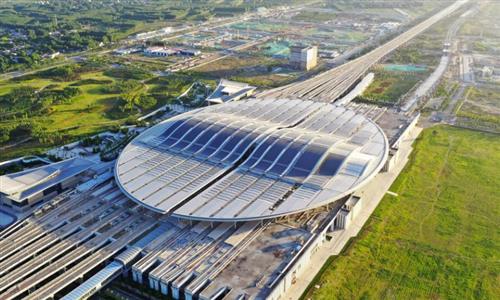
This photo taken on June 29, 2024 shows the Shenzhong Bridge of the Shenzhen-Zhongshan Link in south China's Guangdong Province. The Shenzhen-Zhongshan Link, a mega cross-sea passage in south China that features two bridges, two artificial islands, and an underwater tunnel, opened to traffic at 3 p.m. on Sunday.
Editor's Note: The rise of urban clusters is undoubtedly a significant impetus propelling China's economic miracle. In a recent interview with the Global Times (GT) reporters Bai Yunyi and Wang Yi, Alain Bertaud (Bertaud), a former chief urban planner at the World Bank and author of "Order Without Design: How Markets Shape Cities," discussed the rise of Chinese urban clusters and the influence on China's economic growth.
Bertrand brings a wealth of research experiences and unique insights to his analysis of the exceptional performance of major urban clusters like the Yangtze River Delta and the Guangdong-Hong Kong-Macao Greater Bay Area city clusters. He highlights the significance of scale, agglomeration effect, and innovation capability in the clusters, which underscores the great potential for enhancing China's productivity and lifting Chinese people's broad livelihood.
GT: Have you visited China in recent years? What impressions do you have of the development of Chinese cities and urban clusters?
Bertaud: Unfortunately, I have not had the opportunity to visit China recently. My last trip to China was six years ago. I have tried to follow the land development by observing satellite imagery.
I began working in China during my first visit in 1983 and continued to return to the country until 2018. This experience has enabled me to witness China's development over a period of 35 years. The development of Chinese cities has been absolutely astonishing to me, especially in terms of infrastructure.
What impressed me the most are the large urban clusters in the Yangtze River Delta and the Pearl River Delta - now the Guangdong-Hong Kong-Macao Greater Bay Area (GBA), which has unparalleled size. The San Francisco Bay Area, including Silicon Valley and surrounding areas, is home to approximately 7 million people. The GBA now has a population of around 90 million people, equivalent to the entire population of Germany. The region is increasingly connected by rapid rail. Twenty years ago, it would take about two or three hours to travel from Hong Kong to Guangzhou by train. However, based on the data I have now, the journey only takes about 40 minutes.
In my view, there are still some progresses to be made in transport in the GBA. If this can be achieved, the GBA would be by far the most productive and innovative area in the world. What we have learned in urban development is that if you manage to have a very large labor market, the productivity of this area is much higher than the productivity of smaller cities, even though running a large city is more complex than running a small city.
I'm very encouraged to see that the local governments in China encourage innovation in different type of transport, not only speedy trains, but also self-driving cars. I think that this experimentation is absolutely necessary. In Europe and the US, cities are often hesitant to embrace change, leading to the implementation of regulations that could slow down change there. It appears that the Chinese are facing change much more eagerly and with more imagination.
GT: You once mentioned that China's unprecedentedly huge urban clusters have the potential to usher in a new era of improved productivity and creativity. Could you elaborate on the perspective? Compared to urban clusters in other parts of the world, what advantages do Chinese urban clusters have in terms of scale, economic benefits from concentration, and innovation capability?
Bertaud: I see two advantages.
First, size. I discussed before that China's GBA is larger in size compared to other clusters. If you look at productivity, innovation, size is important.
Second, land use. Many manufacturing enterprises in the San Francisco Bay Area have relocated due to high land prices. The area now primarily consists of research labs, office buildings, and other brain work-related industries. Manufacturing has been outsourced to other parts of the US or even to other countries.
In China, industrial areas continue to remain in clusters like the Yangtze River Delta and the GBA. I believe this creates an advantage because research is important, but researchers must also be exposed to manufacturing in order to improve it. The key is not just inventing new things, but making those inventions work for the common good and commercializing them. I believe that the land use diversity in Chinese clusters is an advantage in achieving this.
GT: In 2017, you said in an interview that the most successful cities are those who embrace rapid urbanization rather than those that try to slow this process down. At that time, you mentioned China's ability to rapidly develop urban infrastructure. In your view, what enabled China to achieve fast urbanization? Is there anything in this process that other developing countries can learn?
Bertaud: I think there are cultural reasons that are difficult to replicate. When I was working in China, I noticed that China has a very clear and efficient decision-making system. This is a major advantage of China, but I am not sure if it's possible to transmit it to other countries.
In many other countries, at a local level of a city, there is a fragmentation of decision-making, which slows down decision-making. For instance, in New York, there has been an effort to implement congestion pricing to reduce traffic in the city center. However, the decision-making process is fragmented, resulting in no progress being made.
GT: You discussed in your book the complementary relationship between infrastructure planning and market mechanisms. What changes do you think have occurred in China's urban planning since the reform and opening-up compared to before?
Bertaud: On the one hand, China has been able to develop top-down infrastructure, which must be designed in advance. On the other hand, the infrastructure has increasingly responded to market demands. I believe this is a significant strength of China. In the West, we sometimes face challenges with our top-down infrastructure due to fragmented decision-making.
Another advantage of China is that the boundaries around cities are very large. There are rural counties that are part of the municipality, which I believe is a significant advantage compared to the fragmentation we sometimes see in the West.
GT: A few years ago, The Economist reported that China is striving to transform itself into a nation composed of 19 major regions based on large urban clusters. At that time, you stated that if integrated properly, China's urban clusters could achieve productivity levels never seen before, "comparable to the gap between the UK and the rest of the world during the Industrial Revolution." Six years later, any change to your prior prediction?
Bertaud: I think that because of the demography now, I will slightly modify my comment 10 years ago. In my opinion, even if some of China's major city clusters succeed, that would be enough to drive the economy of China.
I think that eventually the best city will attract more people. People vote with their feet. The most creative people, more entrepreneurs will be attracted there. I think that's the way probably the Chinese clusters succeed.
GT: In your opinion, what challenges do China's large urban clusters still face, and what can be done in the future?
Bertaud: I think they are on the right track. I will concentrate on the transport and especially the last five-kilometer of transport. From the high-speed railway station to people's final destinations, whether it is a residential area or an office, there is still room for further improvement in the level of transportation and comfort.
The second is housing. Try to increase the supply of housing by encouraging competition, rather than relying solely on large companies. Smaller developers are typically more in tune with local demand and may be more likely to identify opportunities on smaller parcels of undeveloped land. In a city, people of all income levels are essential and should have access to affordable housing.



